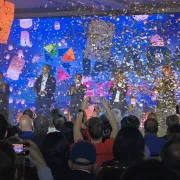SIX YEARS AGO, CALIFORNIA-BASED AUDIOVISUAL solutions provider Mad Systems began exploring ways to provide greater personalized content for museum visitors. How could they deliver customized information at an exhibit, based on a guest’s age, language, and interests? Initially, Mad Systems considered barcodes, RFID wristbands, and QR codes, as well as a custom-made infrared badge. Several shortcomings, though, quickly emerged. For one, devices had to be recharged. Frontline employees would also need to sterilize and properly account for the equipment at the end of a guest’s visit.
“We got to a point where we realized that we needed to find something that we didn’t have to clean or charge and where we didn’t care if people took it home with them,” explains Mad Systems founder Maris Ensing. “Then it became obvious: The best tool is a person’s face. It’s unique and we don’t have to look after it.”
Like others working in this space, as Ensing went down this path he discovered that artificial intelligence-driven advances in facial recognition promise to reshape how attractions engage with guests—and potentially usher in a new era of greater convenience, personalization, and security.
At the Front Gate
Convenience and security were among the driving factors at Changi Airport’s Terminal 4 in Singapore, where cameras with facial and iris recognition technology have replaced immigration officials and cut the time required to clear international travelers by more than half. The technology is also used for check-in, baggage drops, and boarding. Millions of passengers have used the system since it was introduced late last year.
Universal Destinations & Experiences was also an early adopter of facial recognition technology. Photo validation is now an option at the entrances to Universal Studios Florida, Universal Islands of Adventure, and Universal Studios Beijing to provide a faster, more seamless experience for visitors.
“Upon entering the theme parks, guests are asked to take a photo instead of scanning their fingerprint. The image is then securely stored and, on subsequent visits, is used to validate admission,” explains Universal Destinations & Experiences’ Director of Corporate Communications Brian Bruce.
At Universal Studios Beijing, photo validation is also used by guests to rent lockers. The resort’s website notes that facial recognition shortens waiting times and contributes to a lower carbon footprint by eliminating paper tickets.
“Photo validation is completely optional, and guests can choose to opt out of the service at park entry or by visiting guest services before, during, or after their first visit,” Bruce adds. Photos at Universal Studios Florida and Universal Islands of Adventure are deleted within six months of a guest’s visit to the park. Universal Studios Beijing retains digital images and templates for up to one year.
Bruce shares with Funworld that Universal Orlando is preparing to expand its use of facial recognition technology. The operator has already installed cameras at the entrance to Universal Express lanes for several attractions, including the Trolls Trollercoaster in DreamWorks Land at Universal Studios Florida. The biometric system will identify guests and prevent unauthorized access.
Records show Universal has also filed a patent for a machine learning system that uses facial recognition along with temperature, sound, motion, and other sensors to monitor and improve the overall guest experience. In addition to monitoring line jumping and unsafe movement on rides, the Amusement Park Interactive Guidance System can reportedly track liquid consumption and determine if a guest should be flagged from purchasing additional alcoholic beverages. Universal submitted an updated patent application for this technology in 2024, after originally applying for patent protection in 2022.





 The Official Magazine of IAAPA
The Official Magazine of IAAPA








